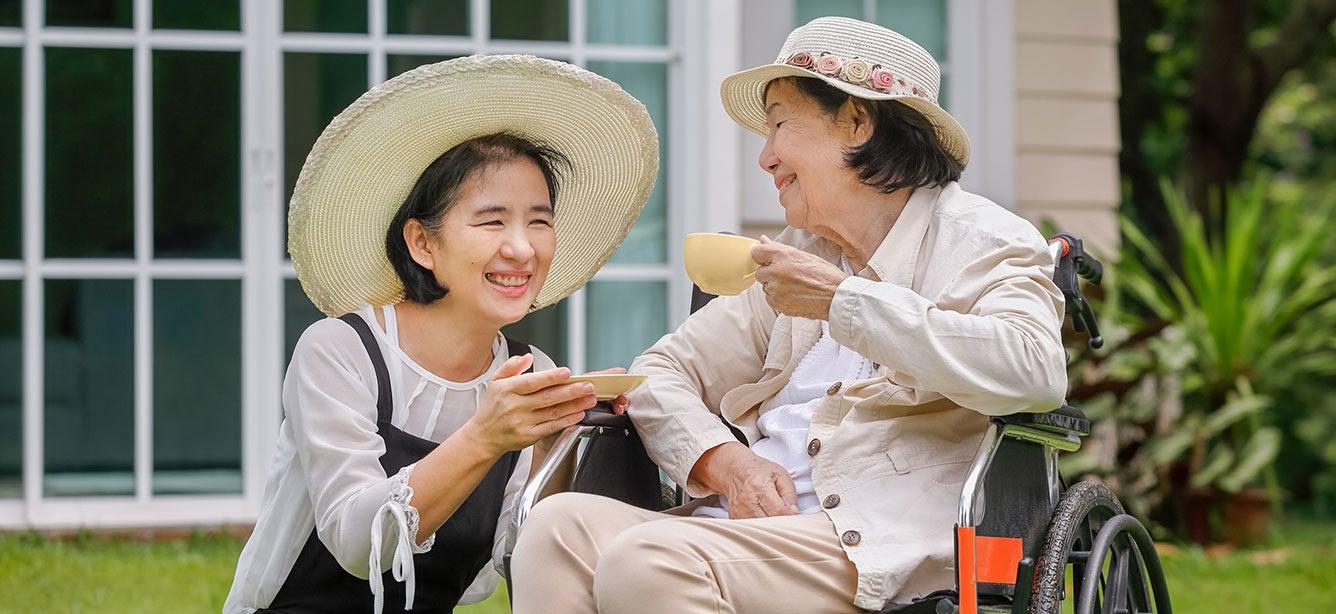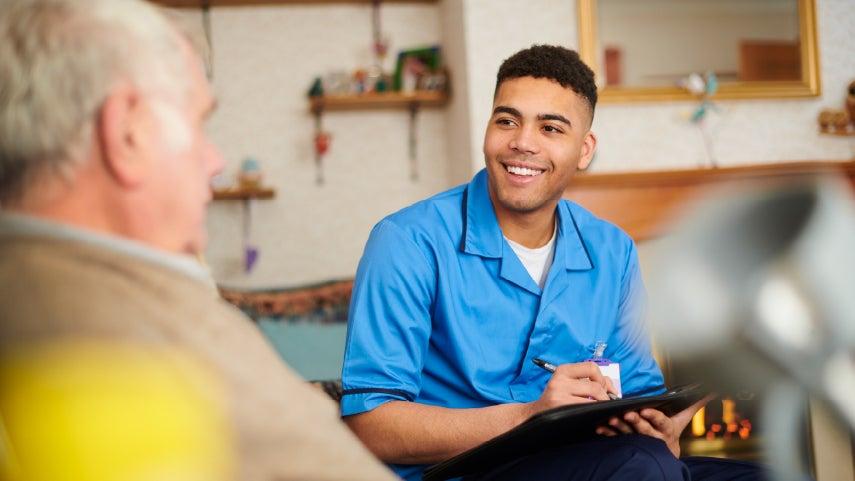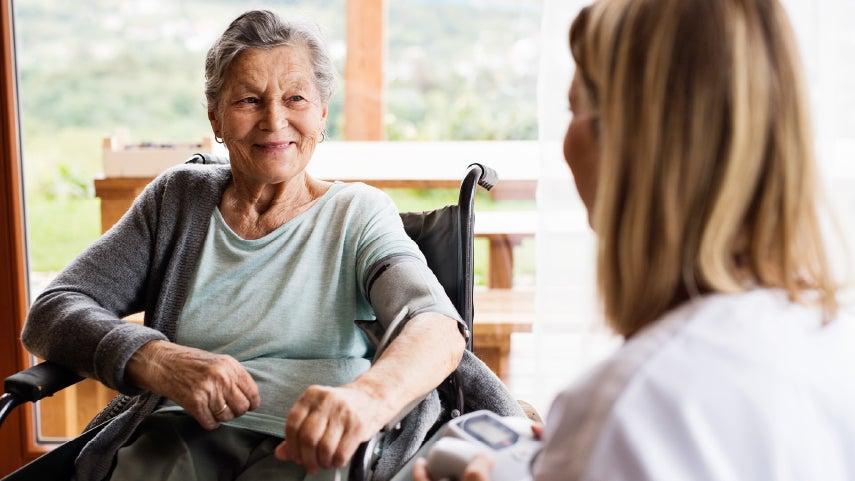
Related Topics
It’s 7:30 am. The alarm has just gone off, and already your brain is buzzing with a to-do list that never seems to shrink—doctor’s appointments, paying bills, buying supplies, giving medications, cleaning the house, getting groceries....
And then, from the next room you hear sounds of stirring, and your body jumps into robot mode while your mind just wants to shut down and go back to sleep. Could you be experiencing caregiver burnout?
What are the symptoms of caregiver burnout?
The American Medical Association identifies these nine key symptoms of caregiver burnout:1
- Feeling overwhelmed or constantly worried
- Feeling tired often
- Getting too much sleep or not enough sleep
- Gaining or losing weight
- Becoming easily irritated or angry
- Losing interest in activities you used to enjoy
- Feeling sad
- Having frequent headaches, bodily pain or other physical problems
- Abusing alcohol or drugs, including prescription medications
Taking care of another person who has complex care needs is often a 24-hour-a-day job with little relief and lots of stress, worry, and physical and emotional demands. And you may be trying to balance caregiving duties with working at your job and/or caring for your children.
No matter how much you love your loved one, be it a spouse, a parent, a child, or whatever the relationship, you can experience burnout at some point. And that’s OK.
None of us is designed to be everything to everyone all the time. And that’s why it is important to know what tools are available to help with the monumental task of caregiving.
What tools can help caregivers?
While this is definitely not an exhaustive list, these three tools can make your caregiving job a little easier:
- Palliative care
- Adult day care
- Respite care
What is palliative care, and how can it help caregivers?
Many people confuse palliative care with hospice care. Palliative care is available for anyone at any stage of a complex illness, while hospice care is for people who are near the end of life.
A helpful description from the National Institute of Nursing Research: “Palliative care can help manage the advanced symptoms of a serious illness and support families. Palliative care provides assistance with advance care planning, goal-concordant care, and provides emotional, social and spiritual support to patients and families.”2
Palliative care can help with things like medication management, pain management, coordination of medical care, transitions between care settings, proper nutrition, counseling, and much more. It is normally delivered by an interdisciplinary care team that includes doctors, nurses, social workers, therapists, and others to help guide you and your loved one through the complicated field of complex care needs. Palliative care is also covered by Medicare and Medicaid, as well as most insurance, and services can be provided in the home or wherever your loved one is living.
What is adult day care, and how can it help caregivers?
Adult day care is a wonderful tool for those with complex care needs, especially dementia. The National Adult Day Services Association recommends day care for those who:
- Can no longer structure their own daily activities
- Find it difficult to initiate and focus on an activity (such as reading, conversation, watching television)
- Are isolated and lonely or desires peer interaction
- Cannot be safely left alone
- Live with someone who works and is away from the home most of the day
- Are anxious or depressed and needs social and emotional support
- Feel uncertain and anxious when left alone
- Require attention that leads to your own anxiety, frustration, compromised health, and/or depression
Adult day care offers a safe, structured environment that provides not only supervision, but also meals, socialization, exercise, and mental stimulation that contribute to an overall better quality of life. Additionally, many adult day centers offer education and support groups for caregivers, and have social workers who can connect you to needed resources. Some adult day care facilities can even help with transportation to and from the facility, administering medication, physical therapy, and other services. While not covered by insurance, some adult day care facilities offer a sliding fee scale based on your income, and the care may be paid for for by other funding sources, such as the VA Aid & Attendance benefit.
What is respite care, and how can it help caregivers?
Another great tool is respite care, which is designed for short-term relief for caregivers so you can go out of town, get rest during a brief illness, or just take a much-needed a break from the heavy responsibility of caregiving. Respite care can take place in an assisted living residence, nursing home, or other setting and can last a few days to a few weeks. While in respite care, your loved one will receive meals, medications, social interactions, and have their care needs met.
According to the National Institute on Aging, “Respite services charge by the hour or by the number of days or weeks that services are provided. Most insurance plans do not cover these costs. You must pay all costs not covered by insurance or other funding sources. Medicare will cover most of the cost of up to five days in a row of respite care in a hospital or skilled nursing facility for a person receiving hospice care. Medicaid also may offer assistance.”3
What kind of team should caregivers assemble?
You may have heard the saying “it takes a village to raise a child.” It also takes a village to care for and older adult with complex needs.
Sometimes that village may include other family members, friends, or neighbors who can bring a meal, or run errands, or mow the lawn. It can also include medical professionals, counselors, and social workers who can do more of the heavy lifting of care.
Being a primary caregiving is a rewarding, but often exhausting, job. You don’t have to work yourself to the point of burnout if you use the tools available to you to aid in your caregiving journey.
Sources
1. Caring for the Caregiver: A Guide fof Physicians. (2018). American Medical Association. Found on the internet at https://www.ama-assn.org/sites/ama-assn.org/files/corp/media-browser/public/public-health/caregiver-burnout-guide.pdf.
2. What is Palliative Care? National Institute of Nursing Research. Found on the internet at https://www.ninr.nih.gov/newsandinformation/what-is-palliative-care.
3. What is Respite Care? National Institute on Aging. Found on the internet at https://www.nia.nih.gov/health/what-respite-care.



